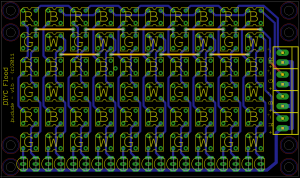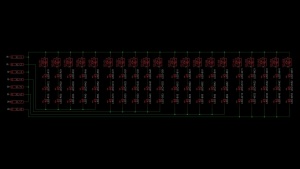DIYC Flood: Difference between revisions
No edit summary |
No edit summary |
||
| Line 5: | Line 5: | ||
==What is the DIYC Flood?== | ==What is the DIYC Flood?== | ||
The DIYC Flood is a four channel LED based floodlight designed for RGB+W lighting. | The DIYC Flood is a four channel LED based floodlight designed for RGB+W lighting. DIYC Flood makes use of inexpensive piranha style LEDs. The use of temperature compensated constant current LED drivers allows the floodlight to operate across a wide range of temperatures and voltages. | ||
==How does the DIYC Flood work?== | ==How does the DIYC Flood work?== | ||
The DIYC Flood was designed to be used primarily as a RGB+W floodlight. The | The DIYC Flood was designed to be used primarily as a RGB+W floodlight. The design allow 4 channels to be switched on/off or dimmed by switching the V- power to ground for the respective channels. It provides a common V+ across all of the channels. | ||
The DIYC Flood | The DIYC Flood was designed to provide a more stable environment for the LEDs by using constant current LED drivers. The [http://www.supertex.com/pdf/datasheets/CL2.pdf Supertex CL2] device provides a constant 20ma thru the LEDs. By using the [http://www.supertex.com/pdf/datasheets/CL2.pdf Supertex CL2] the LED output is maximized while at the same time providing a longer LED lifetime by eliminating the potential to overdrive them due to temperature or voltage variations.<br/> | ||
The basic | The basic electrical layout of the DIYC Flood is an array of clusters of 3 LEDs connected thru a constant current device. There are 5 clusters of 3 LEDs (15 total LEDs) connected to each of the 4 channels. | ||
To ensure the best possible color mixing, the LEDs are arranged with the 4 colors physically adjacent to each other on the PCB.<br/> | |||
==Revision History== | ==Revision History== | ||
The | The v1c version is currently the only version of the DIYC Flood in production. | ||
=DIYC Flood ( | =DIYC Flood (v1c) Parts= | ||
In addition to the PCB, you will need the following components: | In addition to the PCB, you will need the following components: | ||
===Mouser=== | ===Mouser=== | ||
| Line 29: | Line 31: | ||
</table><br/> | </table><br/> | ||
=== | ===LEDs=== | ||
The design calls for 60 Piranha Style Super flux LEDs. These LEDs are single color 20ma | The design calls for a total of 60 Piranha Style Super flux LEDs. These LEDs are single color 20ma devices. The DIYC Flood is designed to use 15 Red,15 Blue,15 Green and 15 White LEDs. <br/> | ||
===Housing=== | ===Housing=== | ||
| Line 52: | Line 54: | ||
=Power Requirements= | =Power Requirements= | ||
The DIYC Flood is optimally driven by 12vdc, but it can be driven by 12-24vdc. The design draws approximately 100ma per channel (400ma total). It is not recommended to use 24vdc if you are planning to use these as a full-time ON | The DIYC Flood is optimally driven by 12vdc, but it can be driven by 12-24vdc. The design draws approximately 100ma per channel (400ma total). It is not recommended to use 24vdc if you are planning to use these as a full-time ON floodlight. The constant current regulators get pretty warm (about 200degF or 95degC) but are still within spec - but not by much. At 12v full on, they run at about 120degF or only just warm to the touch.<br/> | ||
When tested with a "typical" lighting sequence (looping - never all off) of single/multiple/all color fades and on/offs at 24.5vdc and again, everything ran just warm.<br/> | |||
= Controlling the DIYC Flood = | = Controlling the DIYC Flood = | ||
The DIYC can also be driven by a variety of controllers. The [[Ren4Flood|Ren4Flood]] was specifically designed to connect directly to the back of the DIYC Flood in the same housing and provide RENard/DMX control directly at the floodlight.<br/> | |||
Other DC controllers may be used, examples of these are the [[Renard 24LV|Frank's Ren24LV]], a [[Renard_64XC|Ren64XC]] with [[DCSSR|DCSSRs]] and the [[Ren48LSDv3c|Ren48LSD]]. The Ren64XC/DCSSR combination will work as well but it's a more expensive, larger and more cumbersome configuration to use but if you are driving other higher current DC devices, it can work fine.<br/> | |||
The unit may also be directly connected to a 12vdc power supply and act as a constant floodlight. <br/> | |||
Revision as of 00:41, 8 August 2011
DIYC Flood
== THIS IS A WORK IN PROGRESS - NOT FINAL!!! PLEASE CHECK BACK FOR UPDATES!!! ==
What is the DIYC Flood?
The DIYC Flood is a four channel LED based floodlight designed for RGB+W lighting. DIYC Flood makes use of inexpensive piranha style LEDs. The use of temperature compensated constant current LED drivers allows the floodlight to operate across a wide range of temperatures and voltages.
How does the DIYC Flood work?
The DIYC Flood was designed to be used primarily as a RGB+W floodlight. The design allow 4 channels to be switched on/off or dimmed by switching the V- power to ground for the respective channels. It provides a common V+ across all of the channels.
The DIYC Flood was designed to provide a more stable environment for the LEDs by using constant current LED drivers. The Supertex CL2 device provides a constant 20ma thru the LEDs. By using the Supertex CL2 the LED output is maximized while at the same time providing a longer LED lifetime by eliminating the potential to overdrive them due to temperature or voltage variations.
The basic electrical layout of the DIYC Flood is an array of clusters of 3 LEDs connected thru a constant current device. There are 5 clusters of 3 LEDs (15 total LEDs) connected to each of the 4 channels.
To ensure the best possible color mixing, the LEDs are arranged with the 4 colors physically adjacent to each other on the PCB.
Revision History
The v1c version is currently the only version of the DIYC Flood in production.
DIYC Flood (v1c) Parts
In addition to the PCB, you will need the following components:
Mouser
| Mouser BOM | ||
| Mouser PN | Description | Qty |
| 689-CL2N3-G | LED Drivers 90V 20mA Temp Comp | 20 |
| 651-1727078 | Fixed Terminal Blocks 8P 3.81mm 90DEG | 1 |
LEDs
The design calls for a total of 60 Piranha Style Super flux LEDs. These LEDs are single color 20ma devices. The DIYC Flood is designed to use 15 Red,15 Blue,15 Green and 15 White LEDs.
Housing
The DIYC Flood needs to be placed in a housing for display. The small design of the pcb allows it to fit in many common waterproof housings. A common Halogen floodlight fixture can be purchased at most hardware stores.
Building the DIYC Flood
TBD
Congratulations! That completes the construction of the DIYC Flood!
Assembly
TBD
Final Testing
TBD
Mounting in Housing
TBD
Power Requirements
The DIYC Flood is optimally driven by 12vdc, but it can be driven by 12-24vdc. The design draws approximately 100ma per channel (400ma total). It is not recommended to use 24vdc if you are planning to use these as a full-time ON floodlight. The constant current regulators get pretty warm (about 200degF or 95degC) but are still within spec - but not by much. At 12v full on, they run at about 120degF or only just warm to the touch.
When tested with a "typical" lighting sequence (looping - never all off) of single/multiple/all color fades and on/offs at 24.5vdc and again, everything ran just warm.
Controlling the DIYC Flood
The DIYC can also be driven by a variety of controllers. The Ren4Flood was specifically designed to connect directly to the back of the DIYC Flood in the same housing and provide RENard/DMX control directly at the floodlight.
Other DC controllers may be used, examples of these are the Frank's Ren24LV, a Ren64XC with DCSSRs and the Ren48LSD. The Ren64XC/DCSSR combination will work as well but it's a more expensive, larger and more cumbersome configuration to use but if you are driving other higher current DC devices, it can work fine.
The unit may also be directly connected to a 12vdc power supply and act as a constant floodlight.
Schematic
PCB
The PCBs for the DIYC Flood were designed by Brian Ullmark (budude). The PCB was designed to allow users to home etch the board. The layout can be found here.

Design Options
Users can substitute any color LEDs based on their design.
You can omit the terminal block and solder the power wires directly to the PCB.
At the risk to the LEDs, it is possible to substitute a fixed value resistor for the Supertex CL2 constant current device.
Other Information
DIYC Flood Discussion Threads
Initial Thread
Interest Thread
2011 Group Buy
Video
TBD
FAQ
TBD
